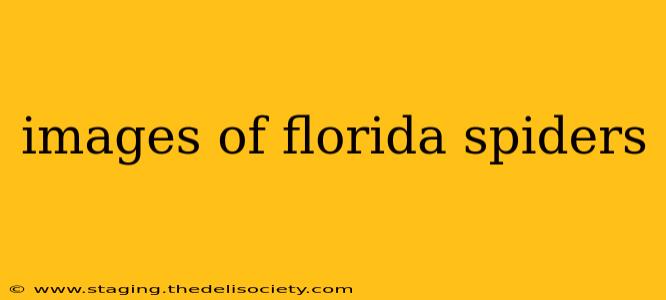Florida's warm climate provides a haven for a diverse range of spiders, some harmless and others potentially dangerous. Identifying the spiders you encounter is crucial for ensuring your safety and understanding their role in the ecosystem. This guide provides information to help you identify common Florida spiders through images and descriptions, emphasizing safety precautions. Remember, this guide is for informational purposes only; never attempt to handle a spider unless you are a trained professional.
Common Florida Spiders: Images and Descriptions
Finding reliable images of Florida spiders can be challenging due to the sheer variety. This guide will focus on some of the most frequently encountered species. Remember to always consult multiple resources for accurate identification.
1. Orb Weavers (Araneidae Family)
Orb weavers are easily recognized by their large, intricate webs. Many are harmless and beneficial, controlling insect populations. Several species inhabit Florida.
- Appearance: These spiders vary greatly in size and color, but typically have round abdomens and long legs. Some exhibit striking patterns.
- Habitat: You'll find orb weaver webs in gardens, shrubs, and around buildings.
- Image Search Terms: "Florida orb weaver spider," "garden spider Florida," "yellow garden spider Florida" (for a specific, common species).
2. Wolf Spiders (Lycosidae Family)
Wolf spiders are hunting spiders, meaning they don't build webs to catch prey. They are often large and hairy.
- Appearance: They typically have brown and gray markings, and their eyes are arranged in three rows.
- Habitat: Wolf spiders live in a variety of habitats, including fields, forests, and gardens. They are often found under rocks and logs.
- Image Search Terms: "Florida wolf spider," "large brown spider Florida," "hairy spider Florida."
3. Jumping Spiders (Salticidae Family)
Jumping spiders are small and known for their incredible jumping ability and excellent vision. They are usually harmless.
- Appearance: They are relatively small and come in various colors and patterns. Many have distinctive markings on their faces.
- Habitat: Jumping spiders are found in diverse habitats, including houses and gardens.
- Image Search Terms: "Florida jumping spider," "small colorful spider Florida," "jumping spider Florida identification."
4. Black Widows (Latrodectus Species)
Black widows are venomous spiders, and their bite requires medical attention. Identifying them is crucial for safety.
- Appearance: Shiny black body with a distinctive red hourglass marking on the underside of the abdomen. Females are larger than males.
- Habitat: They prefer dark, secluded places like woodpiles, sheds, and under rocks.
- Image Search Terms: "Florida black widow spider," "red hourglass spider Florida," "venomous spider Florida." Caution: Use extreme care when searching for images of black widows. Avoid contact.
5. Brown Recluses (Loxosceles Reclusa)
While less common in Florida than other areas, brown recluses are venomous spiders.
- Appearance: Brownish-tan body with a characteristic dark violin-shaped marking on their cephalothorax (head region).
- Habitat: They prefer dark, undisturbed areas.
- Image Search Terms: "brown recluse spider Florida" (Note: Accurate identification can be difficult, and confirmation from a professional is recommended). Caution: Use extreme care when searching for images of brown recluses. Avoid contact.
Safety Precautions When Encountering Spiders
- Avoid contact: The best way to stay safe is to avoid contact with any spider you cannot positively identify.
- Use caution: If you must remove a spider, use a container and a sturdy piece of cardboard or a long-handled tool to avoid a bite.
- Seek medical attention: If you suspect a venomous spider bite, seek immediate medical attention.
Resources for Further Identification
Many online resources and field guides provide detailed images and information on Florida spiders. Consulting multiple sources can increase the accuracy of your identification. Remember that professional entomologists are the best resource for definitive identification if you have concerns.
This guide provides a starting point for your exploration of Florida's diverse spider population. By learning to identify common species and practicing safe handling techniques, you can appreciate these fascinating creatures while ensuring your safety.
